Our SMART LIST of basic art materials.
Stock your classroom or home art space for less than $100!
The internet will have you believe that in order to nurture creativity, you must have hand-carved wooden toys, expensive art materials, and a perfectly organized, rainbow-themed space. We actually think this is completely unnecessary and may even hinder creativity by cultivating a new generation of perfectionist children who are afraid to get messy and make mistakes. In fact, we advocate spending very little on a core collection of hardworking, accessible, resourceful, open-ended tools along with a plethora of repurposed, recycled, natural, and free materials that put the creative power in children’s hands.
Having partnered in many public schools that are equipped with the absolute bare minimum, we know that many budgets do not allow for art materials. With that in mind, we wanted to show how it is possible to stock a classroom with basic materials for less than $100 US dollars. We pulled our prices from Amazon, although we both try not to buy from Amazon as much as possible (and these prices could change with current US tariff wars). Instead, find local shops that stock art supplies, Creative Use shops, Swap Shops, and Buy Nothing exchanges, or you can ask for donations from your school or parent community. (If you do want Amazon links, we are happy to email them to you!)
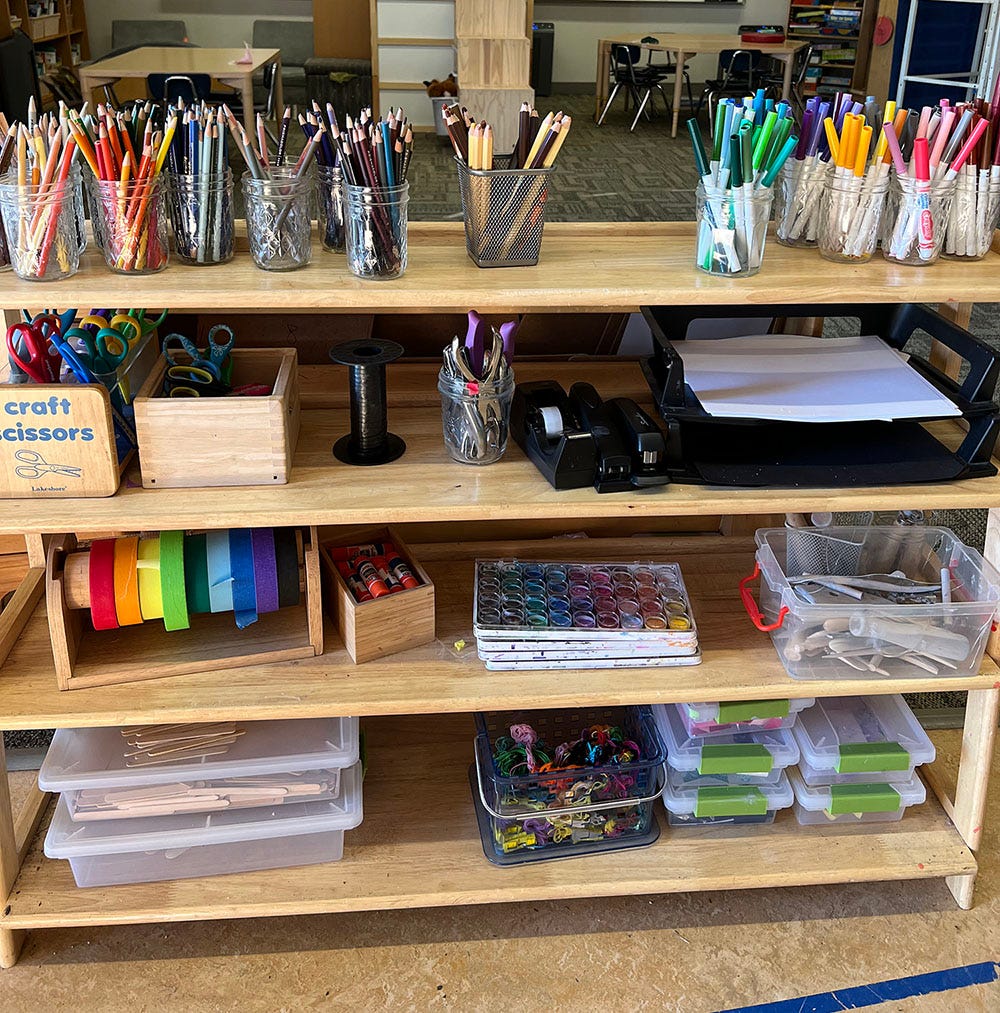
If we had to start an open-ended art and making area completely from scratch, with a very limited budget, here’s what we would pick.
Basic classroom materials (we will assume you already have)
Pencils
Scissors
Crayons
White copy paper
Mark making tools
Colored pencils: Crayola (3.95 for 1 set of 24 colors), or Stabilo Woody for toddlers/preschoolers (15.99 for 1 set of 6 colors).
Washable markers: Crayola (4.49 for 1 set of 20 colors).
Black Sharpies: (4.87 for 1 set of 5 markers). These are great for making bold marks and to pair with watercolor paint. Some of you may be hesitant to stock permanent markers, however, we have found that they are the best on every surface, from cardboard to watercolor paper to plastic bubble wrap.
Paint
Pan watercolors: Shuttle Art dry watercolors (6.99 for 1 set of 48 colors). Depending on how many children will use the space at once, plan for one pan for every two children. One of our Kindergarten partners uses yogurt cups for water, with a black Sharpie fill line drawn so children can do that job themselves.
Nice brushes: Royal (18.30 for 1 set of 12 size 8 brushes). We highly recommend splurging on some nicer brushes instead of using the ones that come with the watercolor set. We promise it will change the experience entirely. These brushes from Royal will last a decade or longer. Keep the cheap brushes to use with glue for collage or other projects with glue.
Sticking + Connecting
Glue Sticks: Elmer’s (12.73 for 30-pack) or Avery (2.99 for 3-pack). These are best to pair with collage experiences. We prefer the ones that have white glue, not purple.
Masking tape: Craftzilla (22.99 for 11 rolls in multi-colors) or Scotch (2 rolls of plain for 6.98). Tape becomes an essential connecting tool when offering a big of cardboard and recyclables. We often will put a bin out on the floor or on a table to create an open-ended maker space.
Wire: Glarks twistie tie wire (10.99 for a 300-yard spool) or Pipe cleaners (7.99 for 1 pack of 300 12” stems in one neutral color). Wire is another excellent connecting tool that is bendable and flexible and can be used for threading many things together. The twistie wire is exactly what it sounds like, similar to the kind you would find on a bread bag. It comes in rolls and can easily be cut with scissors. Or you can get pipe cleaners/chenille stems in one neutral color like cream or beige. This cuts down on having to choose a color or children being disappointed that they didn’t get the color they wanted, and instead, they can focus on innovation and iteration.
Hole punches: (11.99 for 6-pack with ¼” holes, or 2 for 6.98). If you are going to offer wire, hole punches will boost the threading experience. Set out scrap papers, wire, and hole punches for an engaging creative prompt.
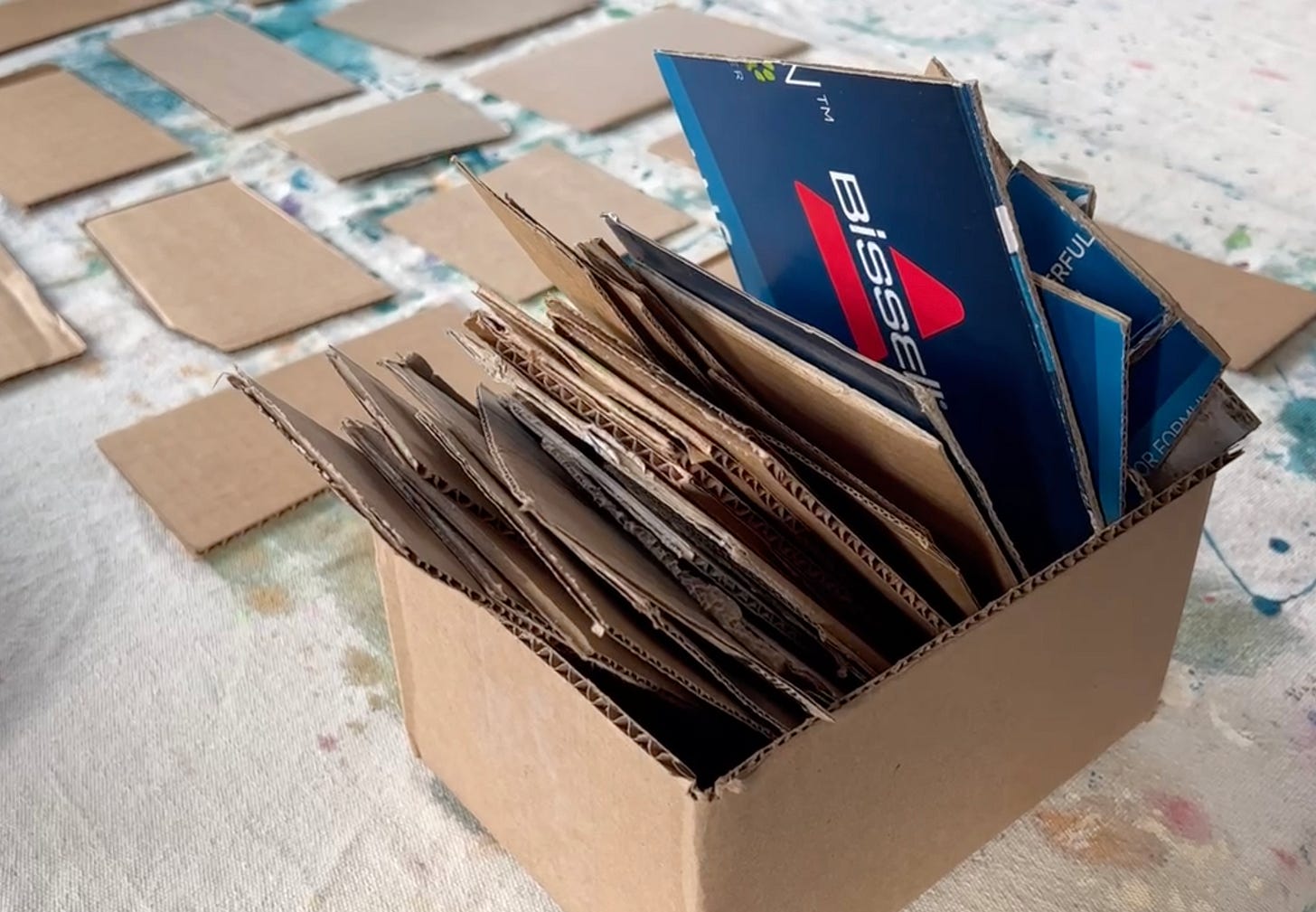
Surfaces
We’re going to try to save as much as possible here by reusing, reusing, reusing. Cut down cardboard into manageable pieces to fit in a cart. Steal all the misprints from your copy machine and cut them down into half and quarter sheets for notes and little doodles. Rescue sun-faded construction paper and magazines or catalogs and cut them up for collage material or leave them in full or quartered sheets to use as surfaces.
Blank index cards: (.75 for a pack of 100). These are great for the message area and for making small drawings, paintings, and notes. Or you could purchase some sturdy cardstock paper (12.99 for 1 pack of 300 sheets) to cut down. It’s heavier than plain copy paper and will hold up to the watercolors and all of the mark-making tools.
Construction paper: Prang white 9 x 12 sheets (4.99 for a pack of 100). This is a step up from copy paper and can be used with paint, collage, and mark-making tools.
Repurposed + Recycled
For small things: Save a big jar or a coffee can in your kitchen for collecting and curating little trinkets like caps and lids, bread tags, springs, nuts, bolts, interesting packaging, twistie ties, and fruit bag mesh. Placing this coffee can in your kitchen or even in a staff break room will make gathering these bits so much more convenient and really encourage your own creative practice of finding possibilities in everything that comes through our environment. Add these items to your making space when the can is full to prompt all sorts of creative making.
For bigger things: Collect bigger things like cardboard boxes that have been cut down, egg cartons, styrofoam packaging for poking, paper towel and toilet paper tubes, and anything that your daily life offers you in a bigger basket or bin. We like using canvas laundry baskets but you can use any bin you might already have.
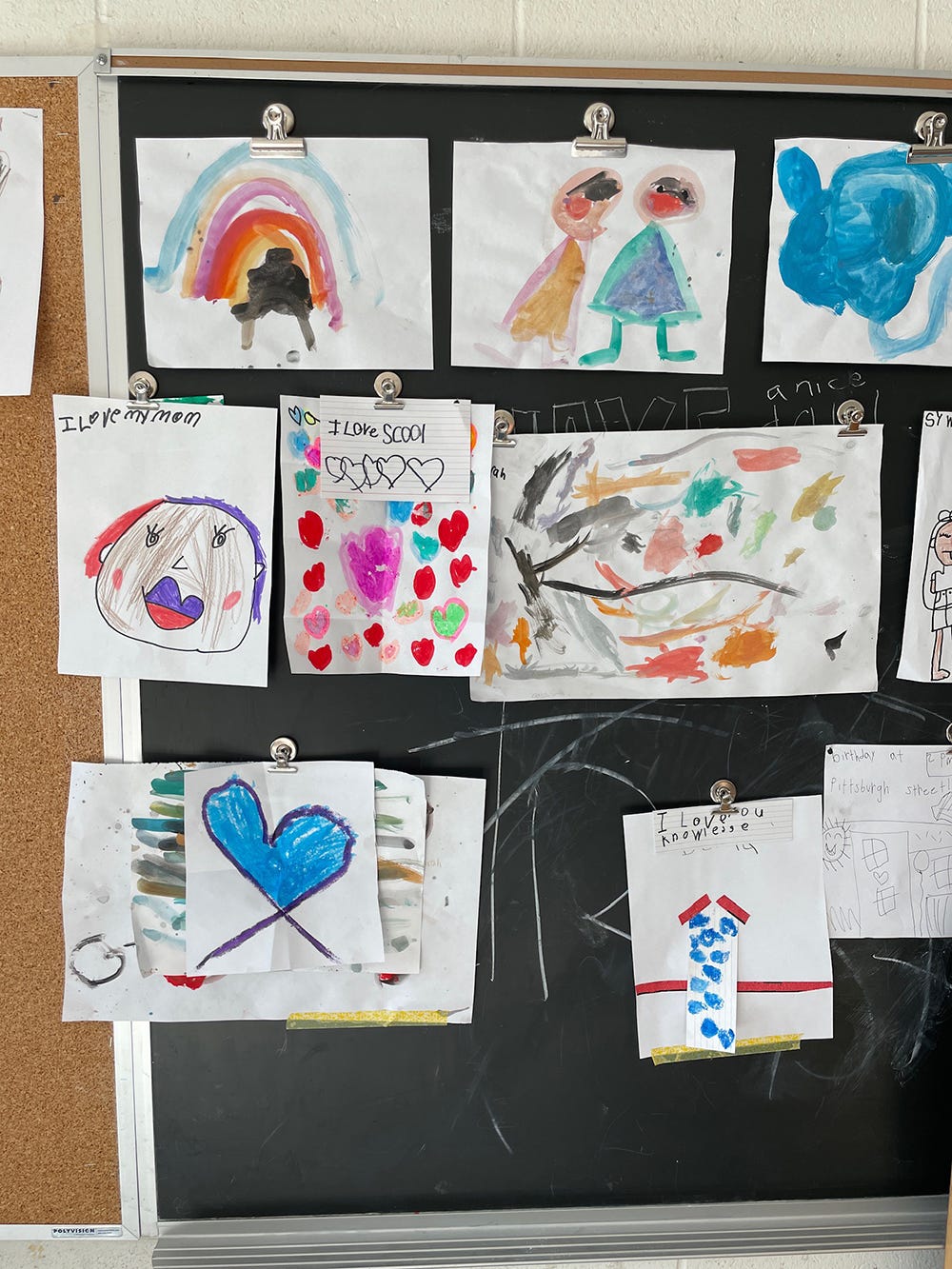
Let’s bundle and total these up. Assuming we have about 6 children in this space at a time, and pairs of children can share materials:
Mark Making: 7.90 to 20.86 (you can choose either colored pencils or markers, Sharpies optional)
Colored pencils (2 packs) 7.90
Markers (2 packs) 8.98
Stabilo chunky pencils (1 pack) 15.99
Sharpies (1 pack) 4.87
Paint: 39.17
Watercolors (3 sets) 20.97
Brushes (1 pack) 18.30
Surfaces: 1.50 to 6.49
Index cards (2 packs) 1.50
White construction paper (1 pack) 4.99
Sticking + Connecting: 30.39
Gluesticks (2 packs) 5.98
Masking tape (plain) 6.98
Wire (1 roll) 10.99
Hole punches (2) 6.98
The grand total…
If you got everything except the chunky Stabilo colored pencils, the total is… ding, ding, ding… $97.80! There is wiggle room to prioritize the chunky pencils if you are working with toddlers. There is also room to level up to the colored masking tape, or add some colored paper (we did not put this in as an essential because we have found that we can get so much colored paper donated by just asking our community – people always seem to have extra construction paper at home that they never use.)
Plus, you’ll add scissors, collected paper scraps, recyclables, and found trinkets and treasures to make the space feel abundant and welcoming. Before you allow tiny budgets or the overwhelming feeling of trying to keep up with Pinterest-perfect studio spaces make you feel like you can’t achieve a very engaging and inspiring art space, look at what you already have and refer back to our last post. Your mindset matters so much more than having exactly the right materials. Children will play, create, and learn with nearly anything. So, carve out some space on a shelf or cart for these basic supplies. Set it up and see what happens. Cultivate the conditions for creativity to thrive, and children will show you what is possible.
Our own favorites, at the moment
Shannon: The supply I can't get enough of right now? Oil pastels and Caran D'Ache Neocolors on cut-up brown paper grocery bags. This paper is a little toothy and sturdy and is just the best (and most ubiquitous) surface for my explorations. I try to pick up this creative practice while my kids are eating breakfast, lingering at the kitchen table, or when I just need a break from reality. I love picking up these tools from our local art store because they pack my selections in the cutest boxes.
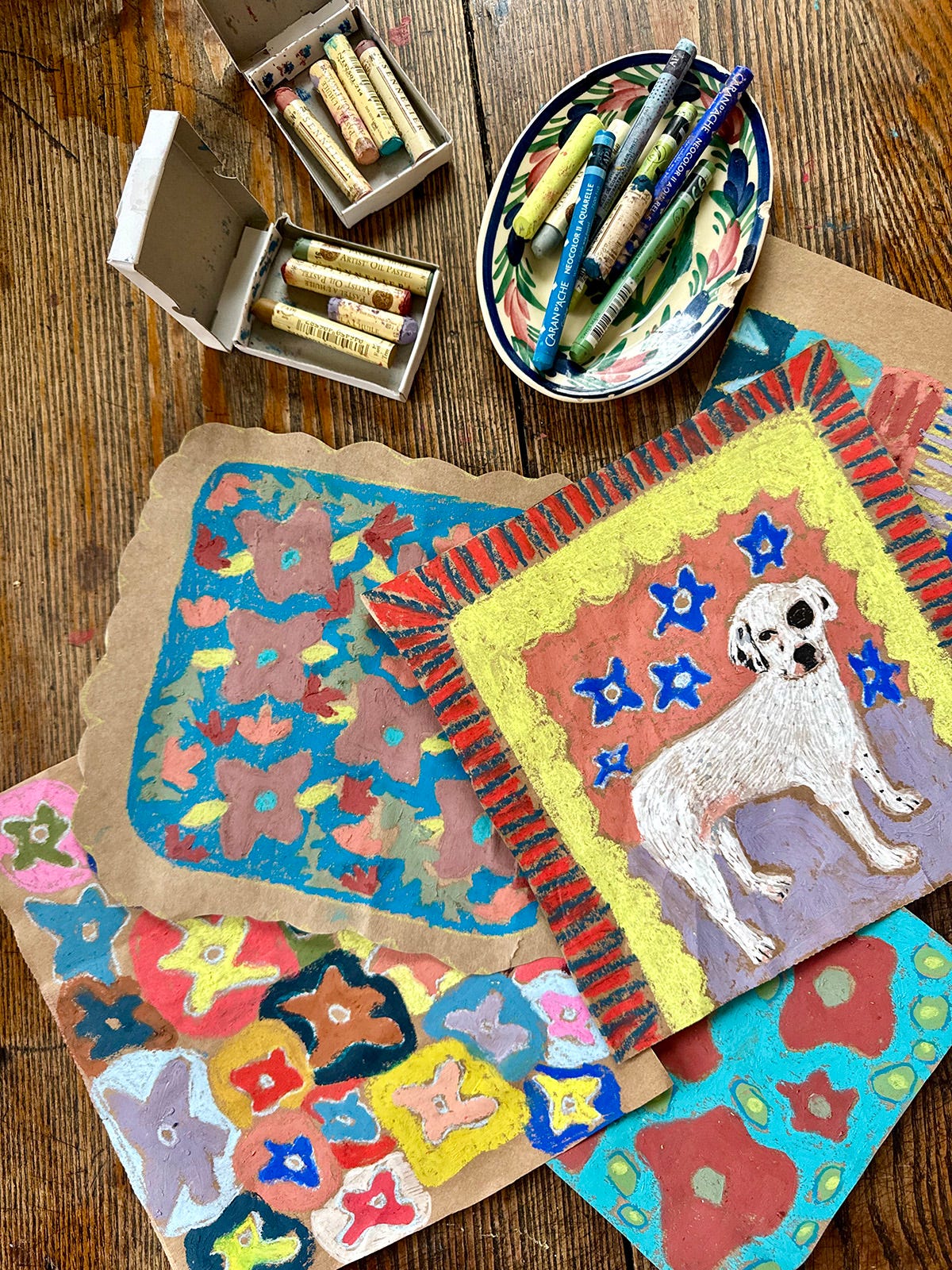
Bar: I have taken inspiration from my library events where the youngest children love the liquid watercolor table and will sit and paint for long periods of time. Recently I used them with some foam brushes and played around with overlapping shapes. I also added some stamping on top after it was dry. I love mixing media and I will always gravitate towards printmaking.




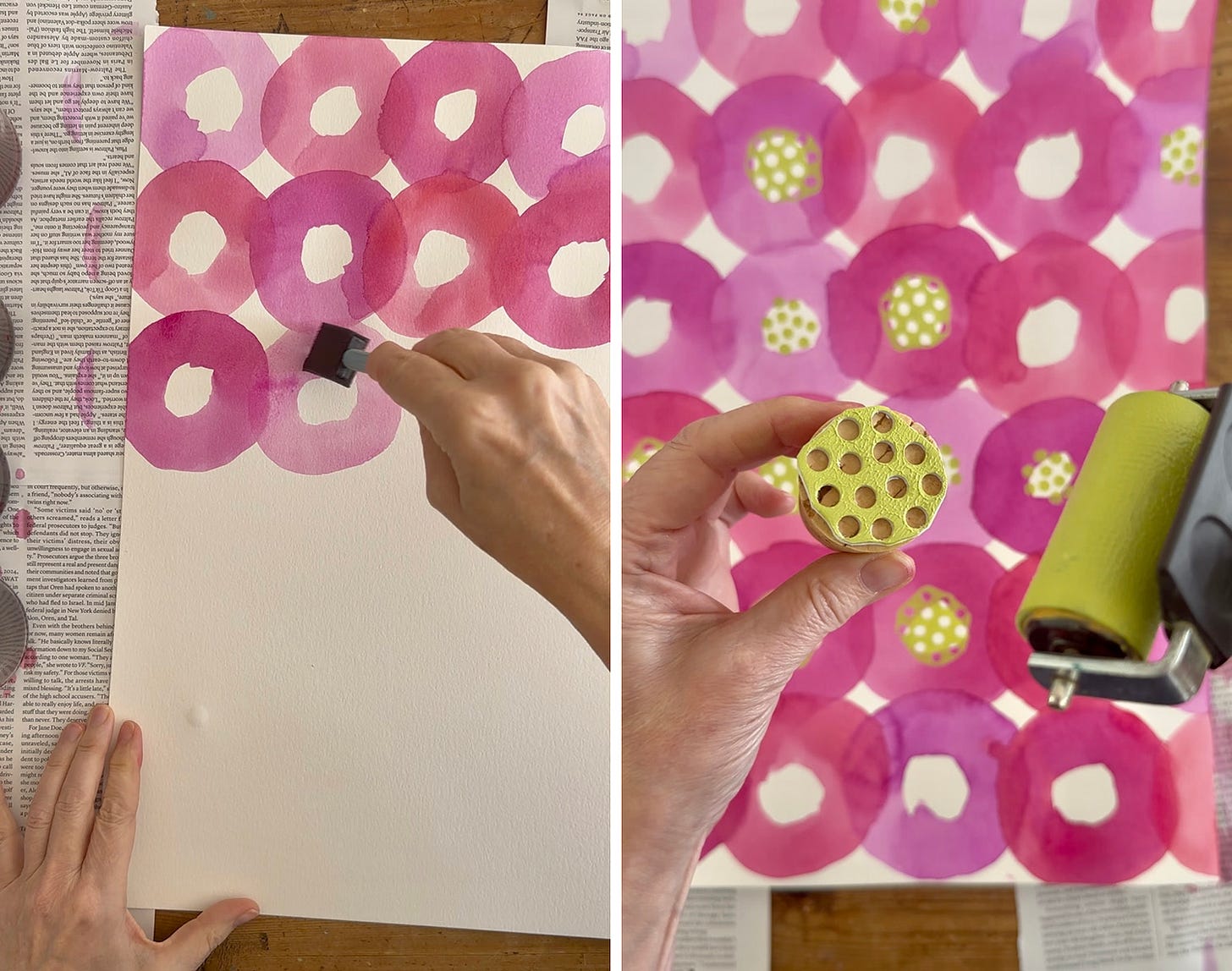
Thankyou for this great list and guide!
It made me think of my grandparents whose carbon footprint would have been tiny compared to mine. They had a reuse for everything. Paper and old envelopes were always in a pile near the drawer of everything. You have reminded me that I had every tool in that house to be creative with and they didn't buy any of it just left me to crack on! I'm going to take inspiration from this with my grandchildren. Thankyou.
I love those little boxes they put the pastels in, too! And I love this list - would also second the recommendation to invest in good brushes. Blick has their ArtPop brand that is affordable as an alternative to Amazon. The waterproof black line pens, good colored pencils, watercolor crayons, and watercolor paper are materials I couldn't do without - thanks so much for putting this together - and for your wonderful Substack which I just discovered yesterday!